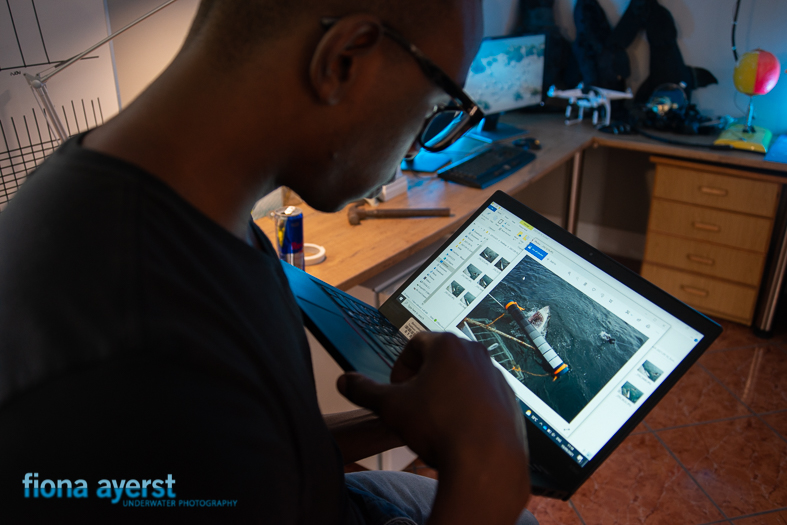
Do Great White Sharks have Camo Sharks Superpowers?
If you’re interested in learning more about new discoveries in the marine science field – look no further!
Discover the adventure and excitement of combining shark science with wildlife filmmaking.

Background to Camo Sharks and their Superpowers
In the picturesque seaside town of Mossel Bay, South Africa the idea for Camo Sharks was born. There’s a shark pantry, a.k.a Seal Island. The island is a 500 m by 80 m rock jutting out of the sea just in front of the main swimming beach. It’s laden with blubbery seals, a favourite food item on the white shark menu. As a result, white sharks are almost constantly in the area.
Ryan Johnson is the director of the Shark Research Unit (SRU), which he established in Mossel Bay in 2007. Ryan realised that Seal Island, as a white shark magnet, was the perfect place for him to establish a science institute. The SRU and the research they’ve done around the island enable Ryan to glean much-needed information about the habits and behaviour of white sharks. Each month students or interns come to study the sharks and assist Ryan’s team with their scientific research.
Gibbs and Ryan Meet and Join Forces
While Ryan was building his institute, he heard about Gibbs Kuguru, a Kenyan scientist studying hammerhead sharks in Mossel Bay. Ryan had presented in several marine-based documentaries and fell in love with the story-telling aspect of film-making. Ryan wanted to make a documentary about hammerhead sharks. Gibbs and Ryan started working together and built a friendship and respect for each other’s work.
Skin Colour Changes in Camo Sharks
On the boat, conducting his research, Ryan noticed skin colour changes in white sharks near the surface. Interested in building knowledge about the natural world, he became obsessed with solving the mystery of how and why white sharks change their colour. He wanted to show people that the white shark’s apex-predator pedestal is not only due to its magnificent set of over 300 serrated, infinitely replaceable teeth. Its success appears to be related to more subtle adaptations, such as changing its colouration and increasing its camouflage. It occurred to Ryan and Gibbs that the best way to do this would be to use their science backgrounds and knowledge of storytelling and make a documentary.
Collaborations to make Camo Sharks
Ryan reached out to National Geographic to support their plans. Nat Geo paired Ryan with Sarah Burns and Alex Sherratt of Roller Coaster Road Productions LLC in the US, and this turned out to be a perfect partnership. Ryan shared his ideas for the film’s contents, and Camo Sharks was born. Gibbs Kuguru is now based at Wageningen University in the Netherlands but returned to Mossel Bay to work with the team of Camo Sharks.
Collecting Skin Samples from Camo Sharks
During the making of the documentary, the team collected living skin samples from white sharks in Mossel Bay. They used a specially constructed spear gun with a biopsy probe fitted to the end, made to take a plug of skin out of the shark. Ryan will never forget when Gibbs took the first shot at a white shark as he felt like a proud father. The team retained a perfect living skin sample in the biopsy tube. As the most powerful microscope in the Western Cape is in Cape Town, The biopsy had to be rushed there on a four-hour trip. Using a time-lapse camera and a confocal microscope, the researchers watched in awe as the great white’s melanocytes—skin cells that contain pigment—contracted and turned lighter in colour when doused in adrenaline. At the same time, another hormone, MSH, or melanocyte-stimulating hormone, caused the same cells to disperse, resulting in darker skin colour.
Gibbs told me, “We wanted to trick these shark cells into thinking they were getting some kind of stimulus, like the sun or an emotional stimulus [such as seeing potential prey] to see if we could get them to change and become lighter or darker,”
“So we tested it, and not only did it work, but it was a swinging success,” says Kuguru, who is also a National Geographic Explorer and 2022 recipient of the National Geographic Wayfinder Award.
Scientific Breakthroughs
This breakthrough marks the start of a cascade of experiments to come, that will show that sharks can change their skin colour depending on their behaviour.
Shark science is like one of those ‘pass-the-parcel’ games. As soon as a scientist makes one discovery, new questions reveal themselves. Even in this study, whilst Ryan and Gibbs were analysing the skin samples, they got clues to further new abilities of sharks that astounded them and have paved the way for future documentaries.
The scientific importance of this novel discovery is that the white shark may be a ‘generalist’, able to adapt quickly and be ecologically successful in various habitats. Such an ability would mean the white shark is more resilient to environmental changes (possibly linked to climate change) than being just a specialist predator.
The Camo Sharks team also looked at another shark already known for camouflage- the puffadder shy shark. The shy sharks’ skin appears to change colour as the small sharks move around different substrates, but these camo sharks also ‘glow’ in the dark. Ryan believes this is a way they communicate with each other.
Superpowers
Ryan believes the ability to camouflage could be a ‘superpower’. Superpowers in animals are typically abilities that animals possess to which humans cannot understand or relate. For example, the electro-reception ability of sharks is a sensory ability we humans struggle to ‘get’. When Ryan sees a shark locate a fish deep in the sand, he realises they are picking up the minute electro fields of hidden fish. This ability never ceases to amaze him. To put this into perspective, white sharks change colour using the same cellular techniques as the octopus!
Once we know more about the camouflage capabilities of camo sharks, this might become a second shark superpower in our vocabulary.
If you’ve ever considered becoming the presenter of a documentary about sharks read on. The shark research you specialise in might be perfect for TV production. Alternatively, you could be interviewed on TV about your research. Possibly, a channel might ask you to share your scientific knowledge in the form of a TV program. You could also be a guest presenter on a series or documentary, like on a Shark Fest show.
With perks like these, it’s hard not to consider becoming a shark scientist. If you have a love for science, sharks and the ocean, you might want to consider becoming a professional in this field. A great way to start building your career in shark science before or during your studies is to join a shark research and development program. This will allow you to gain some valuable field experience in shark science.
Download FREE eBook with 40 proven study-abroad fundraising ideas


Blogger details – Fiona Ayerst
Fiona is the co-founder of Africa Media and a professional underwater camerawoman and photographer. On Camo Sharks, Fiona captured the behind-the-scenes photographs and worked as the second underwater camera operator.



 Let us know where we can send fundraising opportunities. In the meantime download our eBook featuring 18 scholarship awards for study-abroad adventures
Let us know where we can send fundraising opportunities. In the meantime download our eBook featuring 18 scholarship awards for study-abroad adventures  Let us know where we can send fundraising opportunities. In the meantime download 40 great fundraising ideas eBook right here
Let us know where we can send fundraising opportunities. In the meantime download 40 great fundraising ideas eBook right here  Let us know where we can send you more fundraising insights to help jump start your career as a marine scientist
Let us know where we can send you more fundraising insights to help jump start your career as a marine scientist